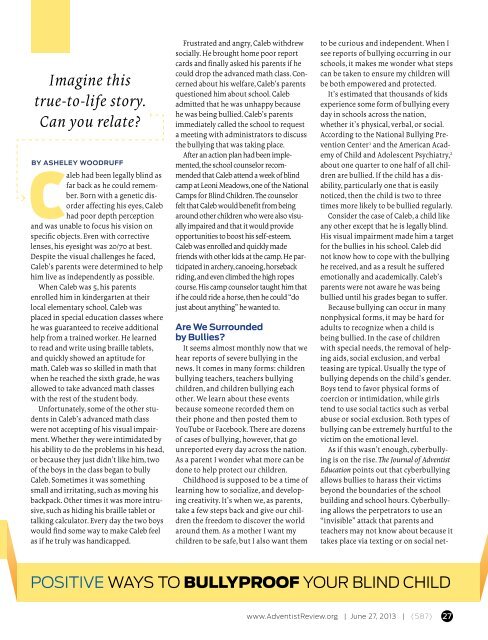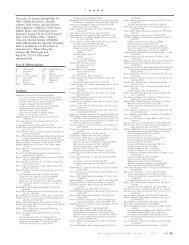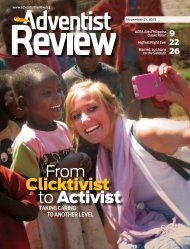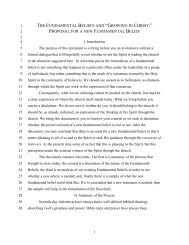Download PDF - Adventist Review
Download PDF - Adventist Review
Download PDF - Adventist Review
- No tags were found...
You also want an ePaper? Increase the reach of your titles
YUMPU automatically turns print PDFs into web optimized ePapers that Google loves.
Imagine this<br />
true-to-life story.<br />
Can you relate?<br />
BY ASHELEY WOODRUFF<br />
Caleb had been legally blind as<br />
far back as he could remember.<br />
Born with a genetic disorder<br />
affecting his eyes, Caleb<br />
had poor depth perception<br />
and was unable to focus his vision on<br />
specific objects. Even with corrective<br />
lenses, his eyesight was 20/70 at best.<br />
Despite the visual challenges he faced,<br />
Caleb’s parents were determined to help<br />
him live as independently as possible.<br />
When Caleb was 5, his parents<br />
enrolled him in kindergarten at their<br />
local elementary school. Caleb was<br />
placed in special education classes where<br />
he was guaranteed to receive additional<br />
help from a trained worker. He learned<br />
to read and write using braille tablets,<br />
and quickly showed an aptitude for<br />
math. Caleb was so skilled in math that<br />
when he reached the sixth grade, he was<br />
allowed to take advanced math classes<br />
with the rest of the student body.<br />
Unfortunately, some of the other students<br />
in Caleb’s advanced math class<br />
were not accepting of his visual impairment.<br />
Whether they were intimidated by<br />
his ability to do the problems in his head,<br />
or because they just didn’t like him, two<br />
of the boys in the class began to bully<br />
Caleb. Sometimes it was something<br />
small and irritating, such as moving his<br />
backpack. Other times it was more intrusive,<br />
such as hiding his braille tablet or<br />
talking calculator. Every day the two boys<br />
would find some way to make Caleb feel<br />
as if he truly was handicapped.<br />
Frustrated and angry, Caleb withdrew<br />
socially. He brought home poor report<br />
cards and finally asked his parents if he<br />
could drop the advanced math class. Concerned<br />
about his welfare, Caleb’s parents<br />
questioned him about school. Caleb<br />
admitted that he was unhappy because<br />
he was being bullied. Caleb’s parents<br />
immediately called the school to request<br />
a meeting with administrators to discuss<br />
the bullying that was taking place.<br />
After an action plan had been implemented,<br />
the school counselor recommended<br />
that Caleb attend a week of blind<br />
camp at Leoni Meadows, one of the National<br />
Camps for Blind Children. The counselor<br />
felt that Caleb would benefit from being<br />
around other children who were also visually<br />
impaired and that it would provide<br />
opportunities to boost his self-esteem.<br />
Caleb was enrolled and quickly made<br />
friends with other kids at the camp. He participated<br />
in archery, canoeing, horseback<br />
riding, and even climbed the high ropes<br />
course. His camp counselor taught him that<br />
if he could ride a horse, then he could “do<br />
just about anything” he wanted to.<br />
Are We Surrounded<br />
by Bullies?<br />
It seems almost monthly now that we<br />
hear reports of severe bullying in the<br />
news. It comes in many forms: children<br />
bullying teachers, teachers bullying<br />
children, and children bullying each<br />
other. We learn about these events<br />
because someone recorded them on<br />
their phone and then posted them to<br />
YouTube or Facebook. There are dozens<br />
of cases of bullying, however, that go<br />
unreported every day across the nation.<br />
As a parent I wonder what more can be<br />
done to help protect our children.<br />
Childhood is supposed to be a time of<br />
learning how to socialize, and developing<br />
creativity. It’s when we, as parents,<br />
take a few steps back and give our children<br />
the freedom to discover the world<br />
around them. As a mother I want my<br />
children to be safe, but I also want them<br />
to be curious and independent. When I<br />
see reports of bullying occurring in our<br />
schools, it makes me wonder what steps<br />
can be taken to ensure my children will<br />
be both empowered and protected.<br />
It’s estimated that thousands of kids<br />
experience some form of bullying every<br />
day in schools across the nation,<br />
whether it’s physical, verbal, or social.<br />
According to the National Bullying Prevention<br />
Center 1 and the American Academy<br />
of Child and Adolescent Psychiatry, 2<br />
about one quarter to one half of all children<br />
are bullied. If the child has a disability,<br />
particularly one that is easily<br />
noticed, then the child is two to three<br />
times more likely to be bullied regularly.<br />
Consider the case of Caleb, a child like<br />
any other except that he is legally blind.<br />
His visual impairment made him a target<br />
for the bullies in his school. Caleb did<br />
not know how to cope with the bullying<br />
he received, and as a result he suffered<br />
emotionally and academically. Caleb’s<br />
parents were not aware he was being<br />
bullied until his grades began to suffer.<br />
Because bullying can occur in many<br />
nonphysical forms, it may be hard for<br />
adults to recognize when a child is<br />
being bullied. In the case of children<br />
with special needs, the removal of helping<br />
aids, social exclusion, and verbal<br />
teasing are typical. Usually the type of<br />
bullying depends on the child’s gender.<br />
Boys tend to favor physical forms of<br />
coercion or intimidation, while girls<br />
tend to use social tactics such as verbal<br />
abuse or social exclusion. Both types of<br />
bullying can be extremely hurtful to the<br />
victim on the emotional level.<br />
As if this wasn’t enough, cyberbullying<br />
is on the rise. The Journal of <strong>Adventist</strong><br />
Education points out that cyberbullying<br />
allows bullies to harass their victims<br />
beyond the boundaries of the school<br />
building and school hours. Cyberbullying<br />
allows the perpetrators to use an<br />
“invisible” attack that parents and<br />
teachers may not know about because it<br />
takes place via texting or on social net-<br />
POSITIVE WAYS TO BULLYPROOF YOUR BLIND CHILD<br />
www.<strong>Adventist</strong><strong>Review</strong>.org | June 27, 2013 | (587) 27

















